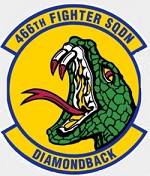Hobby Master HA4419 USAF Lockheed-Martin F-35A Lightning II Joint Strike Fighter - 15-5194, 466th Fighter Squadron "Diamondbacks", 419th Fighter Wing, Hill Air Force Base, Utah, October 2018 [Low-Vis Scheme] (1:72 Scale)
"The F-35 program executive officer, has stated that the 'F-35 enjoys a significant Combat Loss Exchange Ratio advantage over the current and future air-to-air threats, to include Sukhois, which are currently being flown by the Russian, Indian, and Chinese Air Forces.'"
- Maj Gen Charles R. Davis, USAF, the F-35 program executive officer
 The Lockheed Martin F-35 Lightning II is a fifth-generation, single-seat, single-engine, stealth-capable military strike fighter, a multirole aircraft that can perform close air support, tactical bombing, and air superiority fighter missions. The F-35 has three different models; one is the conventional takeoff and landing variant, the second is short takeoff and vertical-landing variant, and the third is a carrier-based variant.
The Lockheed Martin F-35 Lightning II is a fifth-generation, single-seat, single-engine, stealth-capable military strike fighter, a multirole aircraft that can perform close air support, tactical bombing, and air superiority fighter missions. The F-35 has three different models; one is the conventional takeoff and landing variant, the second is short takeoff and vertical-landing variant, and the third is a carrier-based variant.
The F-35 is descended from the X-35, the product of the Joint Strike Fighter (JSF) program. Its development is being principally funded by the United States, with the United Kingdom, and other partner governments providing additional funding. It is being designed and built by an aerospace industry team led by Lockheed Martin with Northrop Grumman and BAE Systems as major partners. Demonstrator aircraft flew in 2000, with the first flight on December 15th, 2006.
The F-35A is the conventional take-off and landing (CTOL) variant intended for the USAF and other air forces. It is the smallest, lightest version and capable of 9 g, the highest of all variants.
Although the F-35A currently conducts aerial refueling via boom and receptacle method, the aircraft can be modified for probe-and-drogue refueling if needed by the customer. A drag chute pod can be installed on the F-35A, with the Royal Norwegian Air Force being the first operator to adopt it.
Pictured here is a 1:72 scale replica of a USAF Lockheed-Martin F-35A Lightning II Joint Strike Fighter that was attached to the 466th Fighter Squadron "Diamondbacks", 419th Fighter Wing, which was deployed to Hill Air Force Base, Utah, during October 2018.
Sold Out!
Dimensions:
Wingspan: 5-3/4-inches
Length: 8-1/2-inches
Release Date: November 2019
 Historical Account: "Diamondbacks" - The 466th Fighter Squadron is the 419th Fighter Wing's operational flying squadron. It is located at Hill Air Force Base, Utah.
Historical Account: "Diamondbacks" - The 466th Fighter Squadron is the 419th Fighter Wing's operational flying squadron. It is located at Hill Air Force Base, Utah.
The squadron was activated late in World War II. Intended as a long-range escort unit, it deployed to the Pacific, but remained in Hawaii until it was inactivated after VJ Day. The squadron was reactivated in 1952 as the 466th Fighter-Escort Squadron, but was inactivated in 1956, when the concept of fighters escorting formations of bombers no longer jibed with United States military thinking.
General characteristics Crew: 1 - Length: 51.4 ft (15.67 m)
- Wingspan: 35 ft (10.7 m)
- Height: 14.2 ft (4.33 m)
- Wing area: 460 ft (42.7 m)
- Empty weight: 29,300 lb (13,300 kg)
- Loaded weight: 44,400 lb (20,100 kg)
- Max takeoff weight: 70,000 lb (31,800 kg)
- Powerplant: 1 Pratt & Whitney F135 afterburning turbofan
- Dry thrust: 28,000 lbf (125 kN)
- Thrust with afterburner: 43,000 lbf[256] (191 kN)
- Internal fuel: 18,480 lb (8,382 kg)
- Performance
Maximum speed: Mach 1.67 (1,283 mph, 2,065 km/h) - Range: 1,200 nmi (2,220 km) on internal fuel
- Combat radius: 610 nmi (1,110 km) on internal fuel
- Service ceiling: 60,000 ft (18,288 m)
- Rate of climb: classified (not publicly available)
- Wing loading: 91.4 lb/ft² (446 kg/m²)
- Thrust/weight:
With full fuel: 0.84; - With 50% fuel: 1.04 B:
- g-Limits: 9 g
- Armament
Guns: 1 GAU-22/A 25 mm (0.984 in) cannon internally with 180 rounds - Hardpoints: 6 external pylons on wings with a capacity of 15,000 lb (6,800 kg) and 2 internal bays with 2 pylons each[60] for a total weapons payload of 18,000 lb (8,100 kg) and provisions to carry combinations of:
- Missiles:
Air-to-air: AIM-120 AMRAAM, AIM-132 ASRAAM, AIM-9X Sidewinder, IRIS-T - Air-to-ground: AGM-154 JSOW, AGM-158 JASSM
- Bombs:
Mark 84, Mark 83 and Mark 82 GP bombs - Mk.20 Rockeye II cluster bomb
- Wind Corrected Munitions Dispenser capable
- Paveway-series laser-guided bombs
- Small Diameter Bomb (SDB)
- JDAM-series
- B61 nuclear bomb (in 2017)
- Avionics
Northrop Grumman Electronic Systems AN/APG-81 AESA radar - Differences across variants
- ^ B is the same, C: 14.9 ft (4.54 m)
- ^ C is same, B: 60,000 lb (27,000 kg)
- ^ F-35B: 14,003 lb (6,352 kg); F-35C: 20,085 lb (9,110 kg)
- ^ F-35B: 7.5 g, F-35C: 7.5 g
- ^ fitted as an external pod with 220 rounds in the F-35B and F-35C
Wingspan: 5-3/4-inches
Length: 8-1/2-inches
|


